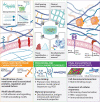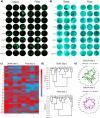Bioactive potential of natural biomaterials: identification, retention and assessment of biological properties
- PMID: 33737507
- PMCID: PMC7973744
- DOI: 10.1038/s41392-021-00512-8
Bioactive potential of natural biomaterials: identification, retention and assessment of biological properties
Erratum in
-
Correction to: Bioactive potential of natural biomaterials: identification, retention and assessment of biological properties.Signal Transduct Target Ther. 2021 May 5;6(1):175. doi: 10.1038/s41392-021-00593-5. Signal Transduct Target Ther. 2021. PMID: 33953157 Free PMC article. No abstract available.
Abstract
Biomaterials have had an increasingly important role in recent decades, in biomedical device design and the development of tissue engineering solutions for cell delivery, drug delivery, device integration, tissue replacement, and more. There is an increasing trend in tissue engineering to use natural substrates, such as macromolecules native to plants and animals to improve the biocompatibility and biodegradability of delivered materials. At the same time, these materials have favourable mechanical properties and often considered to be biologically inert. More importantly, these macromolecules possess innate functions and properties due to their unique chemical composition and structure, which increase their bioactivity and therapeutic potential in a wide range of applications. While much focus has been on integrating these materials into these devices via a spectrum of cross-linking mechanisms, little attention is drawn to residual bioactivity that is often hampered during isolation, purification, and production processes. Herein, we discuss methods of initial material characterisation to determine innate bioactivity, means of material processing including cross-linking, decellularisation, and purification techniques and finally, a biological assessment of retained bioactivity of a final product. This review aims to address considerations for biomaterials design from natural polymers, through the optimisation and preservation of bioactive components that maximise the inherent bioactive potency of the substrate to promote tissue regeneration.
Conflict of interest statement
The authors declare no competing interests.
Figures




Similar articles
-
Potential of plant proteins for medical applications.Trends Biotechnol. 2011 Oct;29(10):490-8. doi: 10.1016/j.tibtech.2011.05.003. Epub 2011 Jun 12. Trends Biotechnol. 2011. PMID: 21665302 Review.
-
Scaffolding polymeric biomaterials: Are naturally occurring biological macromolecules more appropriate for tissue engineering?Int J Biol Macromol. 2019 Aug 1;134:673-694. doi: 10.1016/j.ijbiomac.2019.04.197. Epub 2019 May 1. Int J Biol Macromol. 2019. PMID: 31054302 Review.
-
Polysaccharide-Based Biomaterials in Tissue Engineering: A Review.Tissue Eng Part B Rev. 2021 Dec;27(6):604-626. doi: 10.1089/ten.TEB.2020.0208. Epub 2021 Feb 26. Tissue Eng Part B Rev. 2021. PMID: 33267648 Review.
-
Gelatin-based Targeted Delivery Systems for Tissue Engineering.Curr Drug Targets. 2023;24(8):673-687. doi: 10.2174/1389450124666230605150303. Curr Drug Targets. 2023. PMID: 37282574 Review.
-
Biopolymer-based biomaterials as scaffolds for tissue engineering.Adv Biochem Eng Biotechnol. 2006;102:187-238. doi: 10.1007/10_013. Adv Biochem Eng Biotechnol. 2006. PMID: 17089791 Review.
Cited by
-
Recent Advancements in Materials and Coatings for Biomedical Implants.Gels. 2022 May 21;8(5):323. doi: 10.3390/gels8050323. Gels. 2022. PMID: 35621621 Free PMC article. Review.
-
Identification of a human type XVII collagen fragment with high capacity for maintaining skin health.Synth Syst Biotechnol. 2024 Jun 6;9(4):733-741. doi: 10.1016/j.synbio.2024.06.001. eCollection 2024 Dec. Synth Syst Biotechnol. 2024. PMID: 38911060 Free PMC article.
-
Stem-Cell-Based Small-Diameter Blood Vessels with 3D Printing.Small Sci. 2024 Sep 10;4(11):2400261. doi: 10.1002/smsc.202400261. eCollection 2024 Nov. Small Sci. 2024. PMID: 40213445 Free PMC article.
-
Chitosan-Hydroxycinnamic Acids Conjugates: Emerging Biomaterials with Rising Applications in Biomedicine.Int J Mol Sci. 2022 Oct 18;23(20):12473. doi: 10.3390/ijms232012473. Int J Mol Sci. 2022. PMID: 36293330 Free PMC article. Review.
-
Novel Biocatalysts Based on Bromelain Immobilized on Functionalized Chitosans and Research on Their Structural Features.Polymers (Basel). 2022 Nov 24;14(23):5110. doi: 10.3390/polym14235110. Polymers (Basel). 2022. PMID: 36501516 Free PMC article.
References
-
- Chen R, et al. Biomaterial-assisted scalable cell production for cell therapy. Biomaterials. 2020;230:119627. - PubMed
-
- Williams, D. in Definitions of Biomaterials for the Twenty-first Century 15–23 (Elseiver, 2019).
-
- Zeugolis DI, Pandit A. Biofunctional biomaterials—the next frontier. Bioconjug. Chem. 2015;26:1157. - PubMed
-
- Zeugolis DI, Pandit A. Scaffolds, cells, biologics: at the crossroads of musculoskeletal repair. Adv. Drug Deliv. Rev. 2015;84:v–vi. - PubMed
-
- Ullah S, Chen X. Fabrication, applications and challenges of natural biomaterials in tissue engineering. Appl. Mater. Today. 2020;20:100656.
Publication types
MeSH terms
Substances
LinkOut - more resources
Full Text Sources
Other Literature Sources

